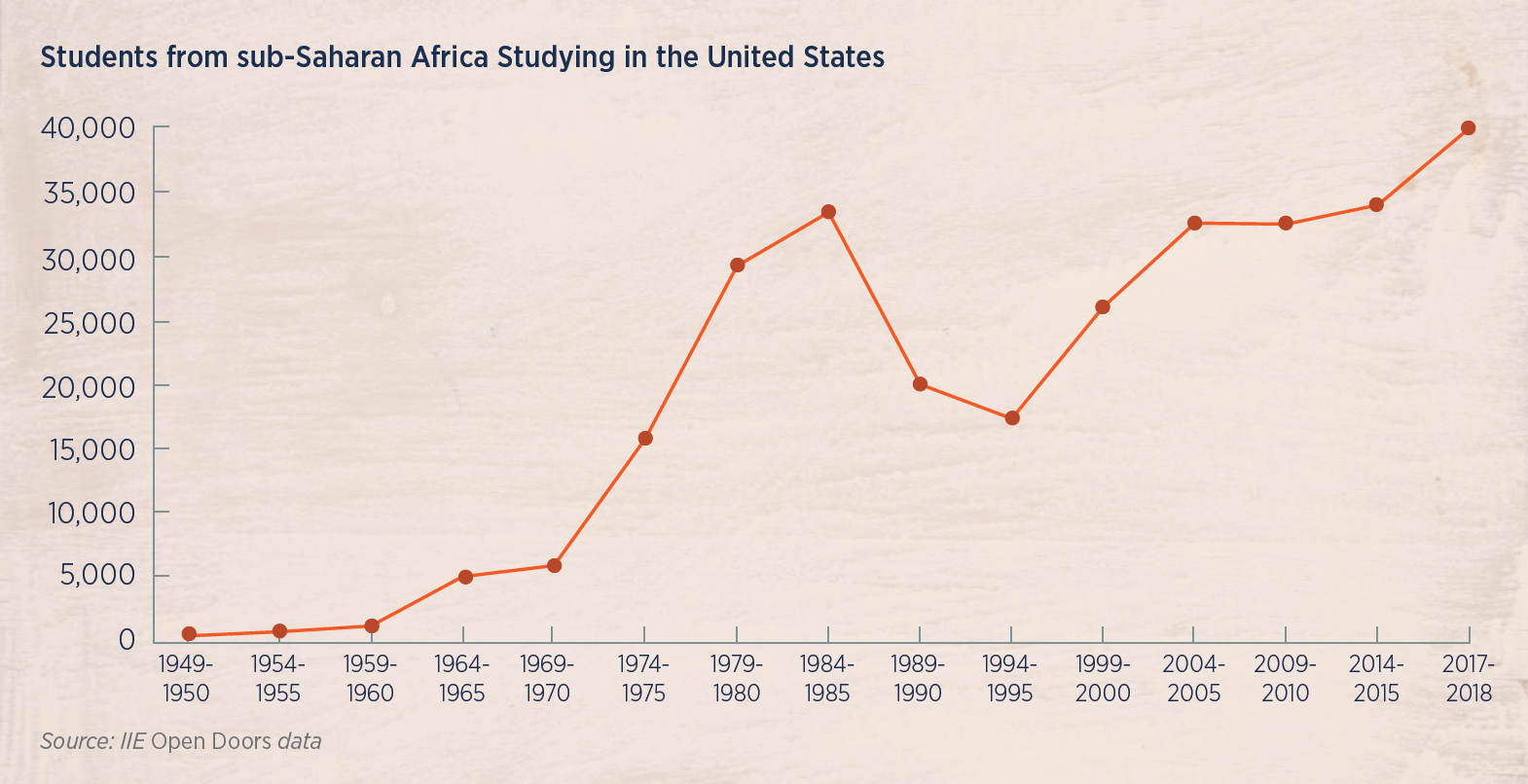Recruiting Across Africa: Best Practices
Where will the United States’s international students of tomorrow come from? To a far greater extent than in the past, the answer may be Africa.
It is an answer dictated by demographics and a huge youth bulge—the median age in sub-Saharan Africa is 19.5 years old—that will cause African students to be a large segment of new international students.
Recruiting more African students will be vital to higher education institutions in the United States for a variety of reasons: diversifying international student populations, recruitment pipelines, and revenue sources, to name a few.
Understanding demographics and changes in mobility patterns, as well as the needs and challenges of students from a diverse continent, is critical to creating and executing a successful recruitment strategy.
Demographics and Mobility Patterns
“Africa is the new China, population-wise,” says Adina Lav, assistant provost for international enrollment at George Washington University (GW). “It is an up-and-coming market.”
The continual rise of African students studying abroad in recent years supports this claim. The share of tertiary international students deriving from sub- Saharan Africa increased from 296,393 in 2012 to 374,423 in 2017, according to United Nations Educational, Scientific and Cultural Organization (UNESCO).
France has historically been the largest destination market for African students seeking to go abroad for higher education, given large investments and ties with its former francophone colonies—especially in North and West Africa—and low tuition for accepted students to most of its institutions. (Though last year, the French prime minister announced that tuition for non-European Union students would increase by 16-fold in autumn 2019.)
Behind France, there is continuing competition for the second spot in the market for African students. In 2014, China surpassed the United States and the United Kingdom—each hosts around 40,000 foreign African students a year, according to UNESCO—to become the second most popular destination for African students studying abroad.
In 2017–18, 39,479 sub-Saharan African students studied in the United States, up 4.6 percent from 2016–17 and representing 3.6 percent of total inbound international students, according to Institute of International Education (IIE)’s Open Doors report. Students from North Africa, a far smaller cohort, numbered 7,268 in 2017–18, down 3.7 percent from 2016–17 and representing 0.7 percent of total students.
Particularly noteworthy has been the steady increase in graduate students from sub-Saharan Africa studying in the United States over the past 4 years, with first-time enrollment growth of 27 percent from fall 2016 to fall 2017 and 5 percent from fall 2017 to fall 2018. These are among the most rapidly growing sending rates of any world region for that two-year period, according to a Council of Graduate Schools study.
This in part reflects that the higher education sector has matured in some African countries, such as Eritrea, Ethiopia, Sudan, and Uganda, says Nancy Keteku, who was EducationUSA’s regional educational advising coordinator for West and Central Africa for 22 years.
Graduate students may be the next largely untapped frontier for many institutions, she says. “There is very little active recruiting going on at the graduate level—there are minimal MBA or STEM fairs,” Keteku says.
Still, overall, mobility patterns of inbound sub-Saharan African students studying at U.S. institutions show a rollercoaster ride over the past 4 decades. This fluxation largely reflects the inbound mobility patterns for Nigeria given the country’s dominant position as the largest sending country and its economic and political struggles, says Keteku.
Generally, African recruiting has been less affected by issues of racial tension, immigration, and U.S. school violence that have become problematic for attracting students from other regions, Keteku says.
“Most of these students have grown up in unstable conditions,” Keteku says. “It takes more than a disrupted political system to discourage them. They have seen worse and say it is relatively better here. We see that now, and we saw the same thing after 9/11. There was a dip in numbers from many locations, but not from Africa.”
Return on Investment
The continent can be a challenging location for recruiting, given its size and expansive linguistic and cultural diversity between regions, as well as within each country’s borders. In many places throughout Africa, limited basic infrastructure—such as internet, telecommunications, roads, and rail systems—that are often taken for granted can hinder travel and communication during recruiting trips.
But the return on investment of time, resources, and finances can reap rewards once students are on campus, and many international educators in the United States say that a good starting point to creating a recruitment strategy is conveying these benefits to campus leadership to create buy-in.
“When I ask U.S. international educators to talk about their African students, their faces light up,” says Diane Weisz Young, regional educational advising coordinator for West and Central Africa at EducationUSA. “For African students to make it to your campus is already an accomplishment. They will work hard, bring a seriousness of purpose, and will not take their U.S. educational opportunity lighthearted.”
And there is the future of student mobility to consider. While most African students at present need substantial financial support from their destination institution, the continent boasts a growing middle class. It is similar to China a generation ago when the country’s prosperity and budding middle class outstripped its tertiary capacity, resulting in the export of a flood of paying, highly qualified international students.
Samba Dieng, director of international students and scholars at Lehigh University in Bethlehem, Pennsylvania, says that they “listed West Africa as a priority region in our internationalization strategic plan, in part because of the emerging economic importance of sub-Saharan Africa and the tremendous recruiting opportunities for the university.”
“We need to figure out how to develop a strategy that allows us sustained engagement, and that means finding a right partner,” he says. “We’re not there yet.”
As many sub-Saharan African students choose the United Kingdom over the United States based upon their parents’ or grandparents’ experiences in the United Kingdom, future African students may well choose to study in a particular location based on mobility patterns being established today, says GW’s Lav.
Some U.S. institutions make the mistake of rushing into recruiting in Africa without fully understanding the complexities involved. “You can’t just say, ‘let’s send or receive students to or from a particular region’ without expertise about that region,” says Margee Ensign, former president of the American University of Nigeria and now president of Dickinson College in Carlisle, Pennsylvania. “It’s important to develop relationships with institutions that share a similar mission. There are many associations set up to establish these partnerships,” she says.
Financial Barriers
A next step in conceiving a recruitment strategy in Africa is recognizing and addressing the significant challenges that recruiting and retaining African international students may represent. Conveying to senior leadership an awareness of the financial and support resources necessary to help many African students to be successful in mobility programs is also an important part of designing an effective program.
At present, most inbound students from Africa will require financial aid, often more extensive than that from other developing world regions. Save for a relative elite and limited middle class, most students do not have access to the same resources as do students in the United States and other more developed countries.
“It is a far better strategy for a U.S. institution to fully fund the reasonable needs of a single inbound African student than to divide that same money up over three students with similar needs,” Young says. “Those students may have no way to make up the gap, even a relatively small gap, and you may end up not reaching any of those students.”
Amherst College in Massachusetts has actively recruited across Africa since 2007; now, about 19 percent of its 160 international students come from the continent. Amherst is in the fortunate position of being able to offer full need-based scholarships to all students, and the majority of African students are fully funded, says Xiaofeng Wan, Amherst College’s associate dean of admission and coordinator of international recruitment.
“We make sure students are not hindered by financial shortfalls,” Wan says. International students average over $62,000 in grant support per year from the college, where 89 percent of them are on aid. Such assistance includes an allowance for an annual round-trip ticket to and from their home country, a start-up grant for first-year students, books, medical and emergency costs, and other expenses.
However, many institutions simply cannot provide that level of assistance, no matter their commitment to bringing African students to their campuses.
“The African international students who apply from impoverished backgrounds want large scholarships,” says Chenelle Goyen, associate director of admissions at the University of Georgia (UGA). “UGA has large scholarships, however it is very competitive to qualify for one.”
Some institutions, like the University of Rochester in New York, use a sliding scale to determine financial assistance, such as the College Board’s CSS Profile application for financial aid.
“Many African students need almost everything,” says Jonathan Burdick, dean of admissions and financial aid for the University of Rochester. They “are often only able to contribute a few thousand [dollars], though there are students from Africa all the way up to full pay.”
Keteku notes that EducationUSA has a vast database on the expenses of studying abroad to help inbound African students identify hidden costs that may derail the feasibility of studying in the United States. The database includes a financial aid table of 1,100 four-year institutions that have given more than $10,000 to individual international students.
Ensuring good communication regarding financial obligations is crucial, says Lehigh’s Dieng. Many African students and parents have a misconception about on-campus employment for instance, he says.
“Many [mistakenly] believe that a student can be supported by the 20 hours they work on campus, if given the opportunity,” Dieng says. “Thus, taking the time to educate African students and parents on finances is, in my opinion, mandatory.”
Testing and Immigration Challenges
Testing and other administrative and legal requirements pose large hurdles for many African students. The enormous barriers that some students face—such as lack of reliable access to the internet, proximity to testing sites, gaps in primary and secondary educations, the needs of other family members, and living in environments affected by privation, conflict, and corruption—means that reducing bureaucratic burdens may be necessary to level the playing field with students from other regions.
“For these students, the admission process is hard enough without adding testing and financial aid applications,” says Keteku. “Asking them to take the SAT or GRE on top of the TOEFL is too much.”
Passing one of several regional exams to attend university, such as the West African Senior School Certificate Examination (WASSCE), may be enough of a proxy, she says.
Institutions in the United States report using different approaches, with some forgoing testing and some reducing application requirements for incoming African students.
“We shifted to test optional 2 or 3 years ago for undergraduates, which has helped undergrads internationally, as well as domestically,” GW’s Lav says.
University of Rochester’s Burdick says that placing a limit on the weight given to standardized tests like the SAT “has paid off beautifully in academic performance and outcomes in terms of careers and graduate education.”
Many recruiters who work with African students say that fully leveraging EducationUSA resources is vital in reaching and preparing students.
“Students who use EducationUSA services qualify for visas,” says Keteku. “That is not because of any inside connection—contrary to popular belief, there is none—but instead because EducationUSA teaches students how to think, how to make their own educational plans and decisions, and how to talk about it. One of the biggest problems that agents face is the low visa issuance rate of their students, because the private consultants do too much of the work for them.”
There are some applicable regional trends, Dieng says. “Some African countries, such as Ghana and Nigeria, have a much higher visa denial rate than Senegal or the Ivory Coast,” he says. “This is also an area that requires education on the part of the U.S. institution.”
Many U.S. institutions offer special support services specifically for international students from Africa. GW, which in 2018 had more than 130 African students, offers success programs to fill in knowledge gaps, such as help with science and mathematics, Lav says.
Dickinson College created a special bridge program for students whose educations have been interrupted by conflict. The program’s first four students, who have since thrived at Dickinson, Ensign says, were students who fled the Boko Haram violence in Nigeria.
Addressing cultural gaps is also important. “One time, I taught a development class [in Africa] and a student refused to look me in the eye or participate,” Ensign says. “I asked him why he wasn’t engaging. He told me, ‘in my high school, if I looked a teacher in the eye, I was beaten.’ You have to understand where these students are coming from.”
Recruitment Strategies
Keeping both student and university goals in mind is pivotal when crafting a recruitment plan. The goals of African international students vary, because as a group they are a diverse population. Many focus on science, technology, engineering, and mathematics (STEM), business, and other pragmatic degrees, given the very real employment challenges many will face when they return to their home country.
Additionally, many students seek opportunities to emigrate permanently, though growing economic opportunities in some African countries are drawing more back home after graduation than in the past, Keteku says.
In 2010, University of Rochester’s Burdick recruited 10 students from Africa on full scholarships, hoping that the initial investment would make Rochester a destination for African students for years to come. The initial 10 students found success at Rochester, and the number of African international students on campus has steadily grown to more than 260 undergraduates from at least 34 African countries, Burdick says.
“We have reached the point where we have probably found our natural limit on need-based financial aid,” Burdick says. “Most [of the African students] are engineering majors, though majors have spread to other things like public health and business. We are now visiting more private schools in Africa than we used to, and our record of success from our African graduates has allowed us to get more doctors’ and diplomats’ kids than we used to. Our goal remains the same: we want the best students.”
Sometimes an inflection point for targeting African students can be the development of an institution’s overall international recruitment strategy.
“When I came to the University of Georgia more than 7 years ago, there was no specific strategic international student recruitment plan; it was mostly based and built on the domestic recruitment plan,” says Goyen, a South African native who came to the United States for her undergraduate and graduate degrees.
As part of developing a strategic recruitment plan, Goyen visited South Africa to connect with the schools that UGA had historically tapped for prospective students. Then, she encouraged African students already studying at UGA to talk with prospective students from their home country about their positive experiences on campus. Goyen even reached out to UGA’s foreign faculty members with connections to Africa.
“If they go to Africa for research or over summer breaks, I would make sure they have admissions material with them in the event that they visit a high school or present at an event there,” she says. “So far, while we have not had mass numbers of students from Africa”—in fall 2017, there were more than 80—“those we have gotten have been academically superior.”
On-the-Ground Recruitment
For many institutions in the United States, recruiting in Africa is a question of budget— how can they make recruitment travel to the continent worth the investment?
To help ensure return on their financial investment and maximize time on the ground, recruiters can learn from what has worked for their colleagues at other institutions. EducationUSA’s Global Guide can be a starting place, as it offers key tips for reaching specific countries on the continent, and its fairs help recruiters meet prospective students. Last year, more than 45 U.S. institutions attended a fair in Nigeria. Goyen says using EducationUSA for connections makes competitive sense, too.
“If students are connected with EducationUSA, then you know they are looking at studying in the United States,” Goyen says.
Some say that Nigeria is a logical starting point for a recruiting trip to Africa. Not only is it the largest sending country in sub-Saharan Africa, but also Nigeria’s geographical proximity to other markets is helpful.
“Ghana is a half-hour away by plane,” says Lav, and Ethiopia, Kenya, and Rwanda are relatively close.
Different markets have different strengths. In particular, Ethiopia, Ghana, Kenya, and South Africa have emerged as strong sources of graduate students, Keteku says.
To enhance on-the-ground travel in a particular country and boost prospective student interest, marketing and admissions materials can feature successful students from that country.
“As soon as students see something with a student from their country, even [a] picture of a student saying, ‘I’m here at this institution,’ they will all apply,” says Keteku. “One institution in Kansas advertised English language programs with francophone African students and started getting applications left and right.”
There are also low-cost recruiting approaches, such as webinars, that help with nontravel recruitment, and some associations can help target good students.
“We work closely with HALI [High- Achieving, Low-Income] Access Network,” says Wan at Amherst College. “A network of schools and nonprofit organizations select and serve HALI students from across the African continent and help them evaluate college options outside of the African continent.”
A Demonstrated Commitment
Much remains to be done by U.S. institutions in an international student market that is increasingly competing for African students, and a demonstrated commitment to African study can help with recruiting.
U.S. institutions “are not nearly as aggressive at recruiting African students as the United Kingdom or Canada,” Dieng says. “The reasons include our lack of university representation in many African markets and the tedious process of admitting African students. It is much easier for African students to be admitted to the UK and Canadian universities than it is to the U.S. [institutions.]”
Both Canada and the United Kingdom have a bigger presence in Africa. The former offers opportunities to immigrate and to study in French, which are appealing to prospective students in francophone countries; the latter has both lower tuition costs and proximity in its favor.
“Canada and the United Kingdom’s presence on the continent is overwhelming and they have some advantages that we don’t have,” says Dieng. “By showing up more, I am confident we can offset some of the disadvantages we have compared to Canada and the United Kingdom.”
Effective recruiting, in part, means conveying the value of the strengths of the U.S. model of higher education. “The quality of teaching, the consistency of education, and state-of-the-art material and labs are all benefits of coming here,” says Young.
“There is also the flexibility of the American liberal arts approach and the fact that students can begin a degree program without knowing what their major will be,” she says. “Once students understand that, they understand its tremendous benefits. In many foreign educational systems, if you start a major and wish to change, it may mean having to pursue a whole other degree. The U.S. system is also unusual in allowing student access to professors. It’s very important prospective students understand these benefits.”
An Anticipated Increase
As more young Africans look abroad to pursue their higher education, institutions in the United States and elsewhere should take steps to attract and retain them—and that starts with a well-planned recruitment strategy. A successful approach takes into account historical mobility trends and demographics, and acknowledges the financial, testing, and immigration challenges many African students face.
By creating solutions to these problems and making a lasting commitment to bring students from across Africa to their campuses, institutions can build a pipeline that will not only deliver significant return on investment, but enrich their student populations and communities.
About International Educator
International Educator is NAFSA’s flagship publication and has been published continually since 1990. As a record of the association and the field of international education, IE includes articles on a variety of topics, trends, and issues facing NAFSA members and their work.
From in-depth features to interviews with thought leaders and columns tailored to NAFSA’s knowledge communities, IE provides must-read context and analysis to those working around the globe to advance international education and exchange.
About NAFSA
NAFSA: Association of International Educators is the world's largest nonprofit association dedicated to international education and exchange. NAFSA serves the needs of more than 10,000 members and international educators worldwide at more than 3,500 institutions, in over 150 countries.
NAFSA membership provides you with unmatched access to best-in-class programs, critical updates, and resources to professionalize your practice. Members gain unrivaled opportunities to partner with experienced international education leaders.















